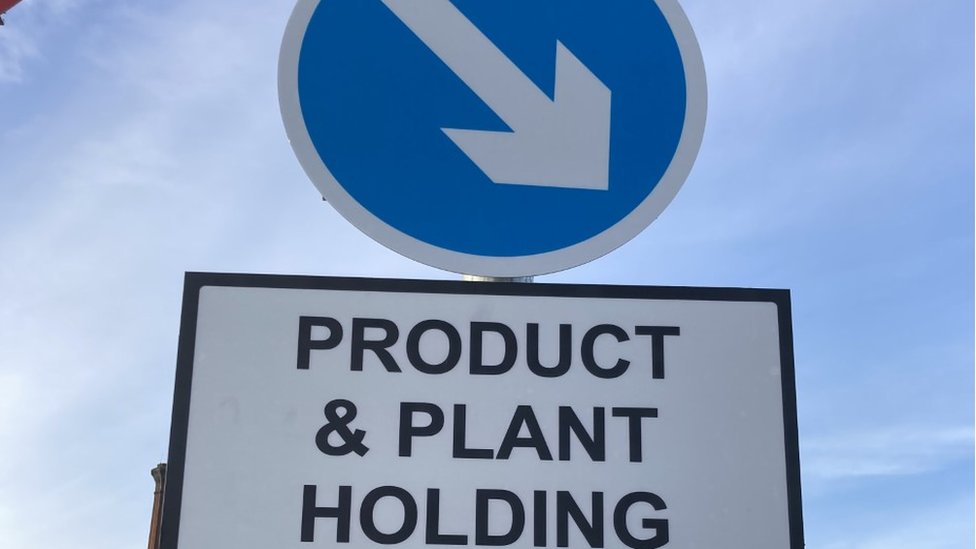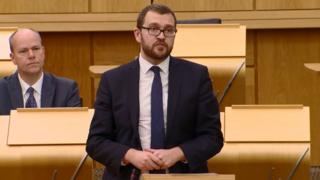
By John Campbell
BBC News NI Economics & Business Editor
When the Brexit transition ends on 1 January there will be a new trade border between Northern Ireland and the rest of the UK.
Northern Ireland will stay in the EU single market for goods and will continue to enforce EU customs rules at its ports.
This will prevent a hardening of the land border with the Republic of Ireland while creating a new “sea border” with the rest of the UK.
January 2017: The Lancaster House speech
During the Brexit referendum campaign in 2016 there was no single vision for the UK’s post-Brexit relationship with the EU.
And outside Northern Ireland there was little discussion about what that relationship might mean for the Irish border or Northern Ireland’s place in the UK.
In the aftermath of the referendum, debate centred on whether the UK should pursue a “soft” or “hard” Brexit.
A soft Brexit meant staying in the EU’s single market or customs union or perhaps both.
A hard Brexit meant leaving both the customs union and single market and reaching a trade deal like the one the EU has with Canada.
A soft Brexit would mean soft trade borders; a hard Brexit would mean harder borders.
In her Lancaster House speech, the then Prime Minister Theresa May sought to end the debate and set a course for a hard Brexit.
image copyrightCrown Copyright
She said the UK would leave the single market and the customs union.
From that moment it was inevitable that there would have to be a new border somewhere.
Simply look at the EU’s other external frontiers with non-single market countries, like the hard border between Hungary and Ukraine.
Even countries which participate in the single market have customs borders with the EU, albeit relatively free-flowing ones.
The speech was not really alive to the implications of this, beyond not wanting to return “to the borders of the past”.
Its main section on Northern Ireland was about maintaining the Common Travel Area, the special bilateral migration agreement between the UK and Ireland.
There was nothing about how the EU, and therefore the Republic of Ireland, would control UK goods entering its single market and customs union.
April 2017: The EU’s negotiating guidelines
Ahead of the first round of Brexit negotiations EU leaders identified three priority issues which needed to be sorted out before they would start talking about a trade deal.
One of them was Northern Ireland and the border.
This was a priority for the Irish government which wanted to avoid a situation where the border could later be used as leverage in the heat of a trade negotiation.
The guidelines, signed off by EU national leaders, stated: “In view of the unique circumstances on the island of Ireland, flexible and imaginative solutions will be required, including with the aim of avoiding a hard border.”
Over the next two-and-a-half years, the Irish government was effective in maintaining this as a firm EU priority.
It meant that from an EU perspective if there was to be a new border it should not be on the island of Ireland.
December 2017: The backstop
Through the second half of 2017 the negotiating teams laboured to find a way to square a hard Brexit with a soft Irish border.
It was in an interim agreement called the Joint Report that the UK implicitly conceded that an Irish Sea border could be a solution.
The Joint Report laid out three possibilities:
- The border issue could be solved in the context of an overall trade deal
- There could be technological and administrative solutions
- Northern Ireland could continue to align with some rules of the internal market and the customs union
It was that third option, known as the backstop, which brought a sea border firmly onto the agenda.
In the days after the Joint Report there was a lack of agreement on what it would mean in practice.
The Democratic Unionist Party (DUP), which was propping up Mrs May’s government, had got language inserted at the last minute which seemed to give them a veto on sea border arrangements.
But in February 2018, the European Commission attempted to sweep away any ambiguity about what the backstop meant.
It published a legal interpretation of the Joint Report explaining it would mean Northern Ireland effectively staying in the EU customs union and following many of the rules of the single market.
Mrs May was clear about what was being proposed.
“The draft legal text the commission have published would, if implemented, undermine the UK common market and threaten the constitutional integrity of the UK by creating a customs and regulatory border down the Irish Sea, and no UK prime minster could ever agree to it,” she said.
For the rest of her time in office she attempted to change and finesse the backstop in ways which would satisfy the DUP, her own party and the EU.
Her failure to do so ultimately cost her her job.
October 2019: Boris meets Leo
Boris Johnson replaced Mrs May in July 2019, promising to get rid of the backstop.
He had been the star at the previous year’s DUP conference, decrying the backstop as a tool to turn Northern Ireland into an “economic semi-colony of the EU”.
But, by October, he was proposing an “all-island regulatory zone” which would effectively keep Northern Ireland in the EU’s single market for agriculture, food and all manufactured goods.
The DUP was on board with that idea as it would need consent from the Northern Ireland Assembly, which would likely have given the party a veto.
However, the Irish government and the EU were not convinced as the plan would have potentially meant a new customs border in Ireland.
They were also concerned an up-front veto for the DUP could prevent the “all-island regulatory zone” from ever materialising.
But then came a meeting with the then Taoiseach (Irish Prime Minister) Leo Varadkar at Thornton Manor on Merseyside.
This would prove to be the engagement which unlocked a deal that ultimately saw an Irish Sea border approved by the UK Parliament.
We still don’t know exactly what the two men discussed.
But whatever Mr Varadkar said it was enough to persuade Mr Johnson to accept a deal with the EU just a week later.
December 2019: General election
The deal which Mr Johnson agreed unambiguously created an Irish Sea border.
It did include a role for the Northern Ireland Assembly, which could overturn the arrangement four years after its implementation.
But that would be by simple majority, meaning unionists would not have a veto.
The DUP, which at that stage was still propping up the Conservative government, was aghast.
There was no way it would support Mr Johnson’s deal in Parliament.
But the election swept away the party’s influence, giving Mr Johnson a comfortable majority.
Without the DUP obstacle he was free to get his deal through Parliament.
Before the end of January the Irish Sea border would be law.
Related Topics
Source link


